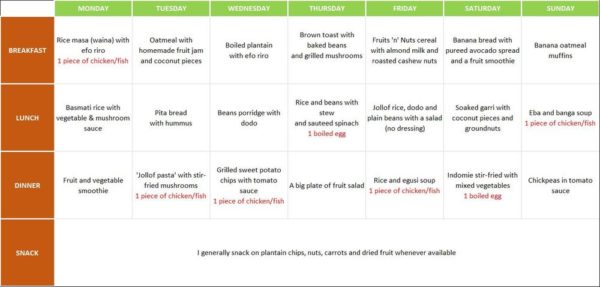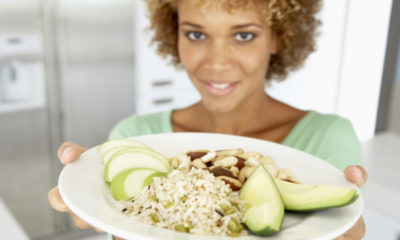Features
Itua Iyoha: How to Adopt a Whole Foods, Plant-Based Diet When You Live in Nigeria
 The first two parts of this series (here and here) covered the health benefits of a whole foods, plant based (WFPB) diet. In this last part I’m going to share some tips for putting it into practice.
The first two parts of this series (here and here) covered the health benefits of a whole foods, plant based (WFPB) diet. In this last part I’m going to share some tips for putting it into practice.
So now you know why a WFPB diet is good for you, but how to do it properly without breaking the bank? You often hear that healthy eating is sooo costly, but it’s really not – unless you’re buying broccoli and beets every day. Also because you will be buying reduced quantities of the most expensive thing in your food basket – meat – you’ll be cutting costs significantly. It is time consuming though, as you’ll need to prepare your own meals at least some of the time. This is the only way to fully control what goes into your food.
The guidelines will be in two parts: how to eat whole foods and how to eat plant based. At the end I’ll share a sample meal table. The table is not meant to be followed as a meal plan; it is only an example of how you can easily get sufficient nutrition on a WFPB diet. Also note that this article is not meant to be an exhaustive guide but merely a starting point; feel free to ask questions in the comments if you have any concerns not addressed here.
Eating whole foods
This one is pretty simple: as much as possible buy foods that are unprocessed or at least not highly refined. You may not be able to eliminate all processed food, but minimising consumption of the worst offenders will have a big impact. When buying packaged food identify the highly refined items by considering how much processing the raw food had to undergo to become the product on the shelf. Take white flour for example. The raw ingredient is wheat kernels. The nutrient rich wheat germ and bran are removed, leaving the starchy endosperm. It is ground up into flour, bleached, and chemicals are added – flour improvers, synthetic versions of lost nutrients. Some of the bran is added back to make ‘wholewheat’ flour. This is a highly refined food. Compare this to yam flour. The yam is peeled, dried and ground up into fine powder. Processed, but not a highly refined food.
Also get familiar with packaging labels. Consider the length and complexity of the ingredients list. As a general rule, the longer the list and the more complex the names, the more processed the food.
You’ll have to do a bit of googling to find out more about specific packaged foods. Question everything. I suggest keeping your phone browser open during you next trip to the supermarket. Shopping will take a bit longer than usual, but after doing this a few times you’ll intuitively know what to avoid. Getting the information yourself in this way is far better than giving you a list of things to avoid.
A special note on oil. Like white flour, oil is a highly refined junk food that should be taken sparingly, if at all. Coconut oil, olive oil and palm oil* are said to be beneficial, but really all types of oil, whether cold pressed or not, are pure fat and have been found to promote inflammation of the arteries, a major precursor to heart disease. We do need fats in our diet, just not in the pure form. To reduce your use of oil in cooking, bake or grill instead of frying, and where a dish calls for palm oil use palm fruit extract instead. To incorporate fats into your food in a healthy way, use whole foods that contain oil like nuts and seeds. You can add them whole or puree them into butter and add to soups or smoothies.
*Note that palm oil is different from the palm fruit extract used for banga soup which is much less refined and contains many other nutrients besides fat, as well as fibre.
Eating plant based
Do not despair; unless you’re vegan, you don’t have to give up animal products completely; you are simply minimising consumption. You can do this one of two ways: either by reducing the meat/dairy/eggs at each meal to less than half of what you currently consume, or eating most meals without any animal products at all. This one might be tricky, as we tend to feel that our food is ‘missing something’ without meat. However what I’ve found is that meat is mostly about texture. If you can get that meaty texture in your food, you might not even notice the absence of meat. Mushrooms are great for getting that chewy texture of meat in your dishes. Legumes also have a good ‘bite’ to them – beans, chickpeas, lentils and other foods in that family – as well as nuts. Some dishes do depend on meat stock for flavour, like our soups, but with some culinary creativity you can cut out all that cholesterol and still have delicious soup. Have a look at the recipes on my blog Naijaveganchef.com for tips on how to achieve the rich flavour and texture of Nigerian dishes using no meat and less oil.
Now if your WFPB diet is going to be sustainable, it can’t be based on elusive, costly items like quinoa. Try to prepare meals you are used to, with ingredients that are common in the market. Remember though, that variety is the spice of life. If you’ve been buying the same bread, yam, rice and spaghetti every time you shop, you need to get out of that rut! Walk around the shop or market and try some (inexpensive) food items you have never had before. Black beans, bambara nut, ukwa, chickpeas – buy them and google how to cook with them. Incorporate them into your usual meals. The more variety in your diet, the more nourished you will be.
When eating out, identify satisfying WFPB-friendly options on the menu.
Most restaurants will have dishes like jollof rice, moimoi, beans, stir-fries or yam porridge where you can control the meat content. Shawarma, chicken salads and pizzas are not a good idea as you can’t reduce the meat without going hungry.
And on that note, please please increase your portions. Yes, you read that right: eat more food, not less. Plants are less calorie dense than animal products, so you’ll need to eat more to get the approx. 2000 calories a day you need. Just listen to your body – eat until you are satisfied, skip a meal if you don’t feel hungry.
Below is a sample week of nutritionally balanced WFPB meals for someone with a 9 to 5, based on what I ate last week.
FYI: I can’t go into detailed nutrition info on every meal, but if you’re concerned about protein you can get the nutrition data using this simple tool. I haven’t included calorie information as there is no need for people eating WFPB to count calories (barring medical conditions).
All of the meals were eaten without animal products; I’ve indicated in red text where I would’ve had them.
During the week most of my meals are eaten outside the house, on weekends I eat at home.
Thanks so much for following the series! I hope this information is helpful to you as you consider (and hopefully adopt) a WFPB diet. The change may be difficult at first, but remember it only takes 21 days for a new habit to become routine. Live long and prosper.
Do you think a whole foods, plant based diet is a realistic path for you? Is it something you might try or are you even already doing it? Please share in the comments.
Photo Credit: Dreamstime


























